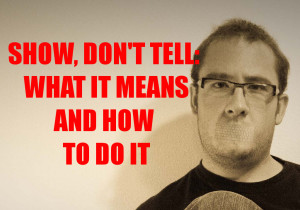So let’s finish up Example Number 2 from last week.
Once again, the background exposition (telling):
I had been the youngest ever accepted into the Academy, and the quickest ever to graduate. Since then, I had sought out every acclaimed blade-wielder in the five kingdoms, and defeated them all. I had come to this city for one reason only; to challenge the last.
The fix (showing):
I rapped my knuckles on the bar to get the innkeeper’s attention. He finished drying a tankard before leaning towards me.
“What’ll ye have?”
“I need a room.”
“Name?”
“Lister.”
He snorted. “Any relation to Gavin Lister?”
“That’s me.”
The innkeeper chuckled.
Then he saw my serious expression and sobered momentarily in disbelief.
Then he laughed even louder.
“Ye want me to believe you’re the fellow made the best swordsmen in five kingdoms look like fools wavin’ broom handles? Ye’re not even old enough to go to the Academy.”
I sighed. Starting tomorrow, I was growing a beard. “Why don’t you pick out the best swordsman in this room?”
“And?”
“And if he kills me, you get everything I’m carrying here, which is more than enough gold to pay someone to mop up the blood. If I kill him, I get a room.”
My confidence made him hesitate, but as he eyed me, I saw him decide that I was bluffing. He smiled and began scanning the room for a suitable challenger.
A quarter of an hour later, I was following the innkeeper up a narrow flight of stairs. He kept glancing back over his shoulder at me, and after opening the door to my room, he stood aside to let me pass, his chin hanging open as if he was trying to say something.
“You’re…here to fight the Sword Master, then?” he said at last. His tone was a pleading, pathetic version of what it had been.
“That’s right.”
“No man has ever crossed blades with him and lived.”
“Good,” I said. “I’d hate to be unevenly matched.”
I shut the door and locked it.
So, did we hit the same points we hit last week? Let’s see…
Show the past by telling the present consequences
His past: accomplishing a lot at a very young age. The consequence: difficulty convincing strangers he really is Lister due to his young appearance.
Give your reader clues, not facts
We know he’s new in town because he’s looking for a room. We know he’s famous, because a stranger knows his name and history. We know he’s young because of the innkeeper’s disbelieving comments.
Work those clues into the action and dialogue
I let the innkeeper talk about Lister’s reputation, rather than letting Lister think it to himself; otherwise it sounds like bragging. Also, Lister’s action in actually fighting someone shows us he’s the real deal, rather than just somebody who forged a fake reputation and talks big. Lastly, as an added bonus, we see that he readily kills his opponents, and that he’s undefeated.
Be careful with dialogue, though. It’s easy to shove all your background exposition into dialogue and think it’s okay. It’s not.
Remember this rule of thumb: never make a character say something he wouldn’t naturally say. If you’re forcing words into his mouth, that’s how it will sound—forced.
—
Read more:
Show Don’t Tell on: description, telling to show, and character development.
—




